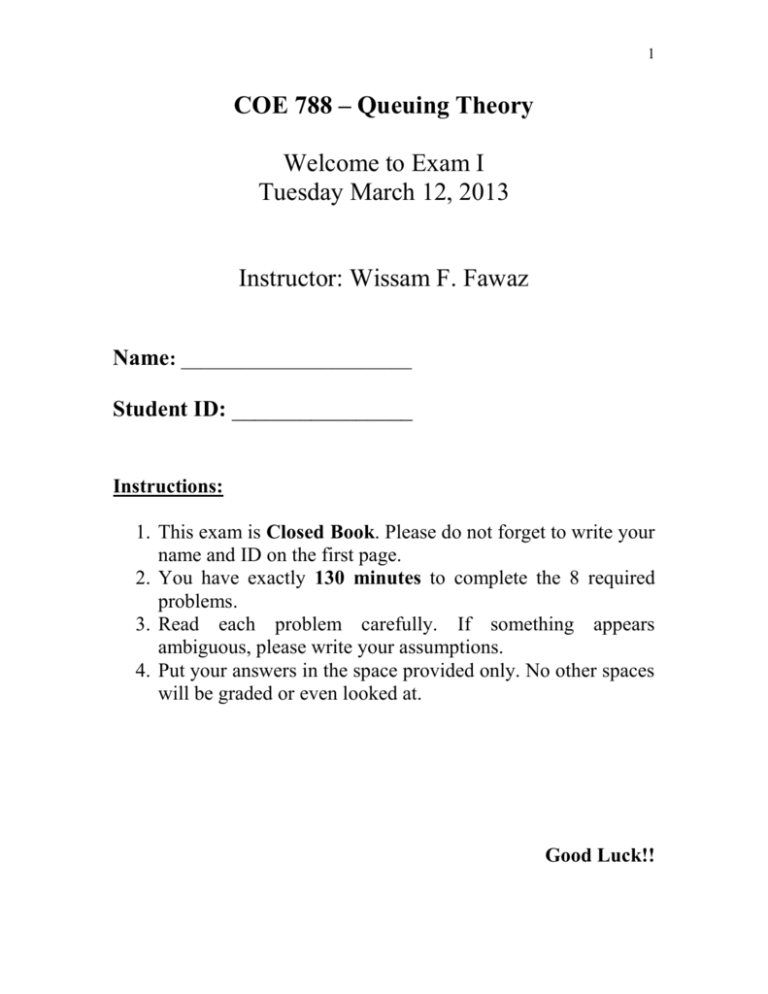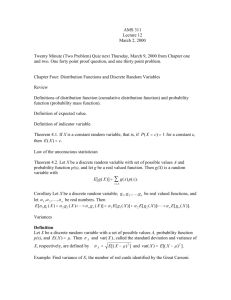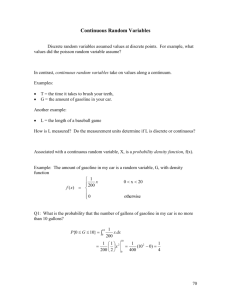Exam I
advertisement

1 COE 788 – Queuing Theory Welcome to Exam I Tuesday March 12, 2013 Instructor: Wissam F. Fawaz Name: _______________________ Student ID: ________________ Instructions: 1. This exam is Closed Book. Please do not forget to write your name and ID on the first page. 2. You have exactly 130 minutes to complete the 8 required problems. 3. Read each problem carefully. If something appears ambiguous, please write your assumptions. 4. Put your answers in the space provided only. No other spaces will be graded or even looked at. Good Luck!! 2 Problem 1: Fill-in the blanks (15 minutes) [10 Points] 1. If the probability mass function of a discrete random variable X is defined as P(X=x) = ax, for x = 1, 2, 3, 4, then the value of a is ____1/10________ 2. If the cumulative distribution function F(x) of a discrete random variable X is defined as follows: F(1) = 0.4, F(2) = 0.7, F(3) = 0.9, and F(4) = 1, then it follows that the value of the probability mass function P(X=x) at X = 3 is ____0.2____ 3. If the probability mass function P(x) of a discrete random variable X is given as follows: P(0)=0.15, P(1)=0.3, P(2)=0.2, P(3)=0.1, and P(4)=0.25, then the value of the cumulative distribution function F(x) at X = 2 is ____0.65_____ 4. If the expected value of a discrete random variable X is E[X] = 5, then E[2X+3] is equal to ____13________ 5. If the assembly time for a product is uniformly distributed in the range of 15 to 20 minutes, then the probability of assembling the product between 16 and 18 minutes is _____2/5_______ 6. Let the random variable X1, X2, …, Xn have mean values of µ1, µ2, …, µn respectively. If the random variable Y is defined as: Y = a1 X1 + a2 X2 + … + an Xn, where a1, a2, …, an, and n are numerical constants, then E[Y]= __ a1 E[X1]+ a2 E[X2]+ … + an E[Xn]____________ 7. Let the random variable X1, X2, …, Xn have variances of σ12, σ22, …, σn2. If the random variable Y is defined as: Y = a1 X1 + a2 X2 + … + an Xn, where a1, a2, …, an, and n are numerical constants, then Var[Y]= __ a12 σ12 + a22 σ22 + … + an2 σn2____________ 8. Let X and Y be two continuous random variables, and let f(x, y) be their joint probability density function. The marginal probability density function of Y can be obtained by ____integrating__________ f(x, y) over all possible value of the variable ____X__________ 9. Let X be a discrete random variable with E[X] = 4.5 and E[X2] = 26.25. The standard deviation corresponding to X is equal to _2.45_____________ 10. The residual distribution function RDF(x) for a continuous random variable X is the area under the density curve to the ____right__________ of x. 3 Problem 2: Multiple choice questions (15 minutes) [10 Points] 1. Consider a non-negative random variable X that has an expected value E[X] = 1 and a variance Var[X] = 3. Which of the following statements are true about X? a. Var[2X] = 6 b. E[X2] = 1 c. Var[X + 3] = 6 d. None of the above 2. The probability mass function of a discrete random variable X is defined as P(x) = x/10 for x = 0, 1, 2, 3, 4. Under this condition, the value of the cumulative distribution function F(x) at x = 3 is a. 0.1 b. 0.6 c. 0.9 d. None of the above 3. When evaluated explicitly, the following summation yields: a. 910 b. 109 c. 99 d. None of the above 4. When evaluated explicitly, summation yields: a. 1 b. ¼ c. (½)4 d. ½ (correct answer) the following 5. If the cumulative distribution function F(x) of a discrete random variable X is given by F(0) = 0.30, F(1) = 0.70, F(2) = 0.9, and F(3) = 1.0, then the value of the probability mass function P(x) at x = 1 is a. 0.3 b. 0.4 c. 0.2 d. None of the above 6. Let X be a discrete random variable with Var[X] = 8.6, then Var[3X + 5.6] is a. 77.4 b. 83.0 c. 31.4 d. None of the above 4 7. Which of the following statements is true? a. For any discrete random variable X and constants a and b, E[aX+b] = (a+b).E[x] b. For any discrete random variable X and constants a and b, Var[aX+b] = (a+b)2.Var[X] c. If a constant c is added to each possible value of a discrete random variable X, then the variance of X will be shifted by that same constant amount. d. None of the above 8. If X1, X2, X3 are three independent random variables with variances 2, 4, and 5, respectively then Var[2 X1 +3 X2 + 4 X3] is a. 32 b. 108 c. 180 d. None of the above 9. The probability density function of a continuous random variable X is defined as: f(x) = 0.5x when 0 ≤ x ≤ 2, and f(x) = 0, otherwise. In this case, P(1≤x≤1.5) is: a. 0.5625 b. 0.3125 c. 0.4375 d. None of the above 10. Let X be a continuous random variable with probability density function f(x) and cumulative distribution function F(x). For any two numbers a and b with a < b, which of the following equalities is true? a. P(a≤X≤b) = F(a) – F(b) b. P(X > a) = 1 – F(a) c. F(x) = (x – a)/(b – a) d. None of the above 5 Problem 3: Poisson distribution (15 minutes) [15 Points] 1. Service calls arrive at a maintenance center according to a Poisson process and the average number of calls arriving per minute is 2.7. Find the probability that: a. no more than 4 calls arrive in any minute 4 4 e 2.7 2.7 x P X 4 p x ; 2.7 0.8629 x! x 0 x 0 b. fewer than 2 calls come in any minute; and 1 1 e 2.7 2.7 x P X 2 P X 1 p x ; 2.7 0.2487 x! x 0 x 0 c. more than 10 calls come in a 5-minute period 10 10 13.5 e 13.5 x P X 10 1 P X 10 p x ;13.5 1 x! x 0 x 0 P X 10 1 0.21123 0.78877 2. A communication system has on the average 26 component failures per year of the same plug-in element. These elements are replaced from available stock which is replenished every two weeks. a. Calculate the rate at which component failures occur in a two-week long time interval? b. The communication system is forced out of service if the number of failures in a 2-week time window exceeds the number of spares available in the stock. Given that there is only one spare element in the stock, what is the probability of the system being forced out? c. How large should the stock be to prevent with a probability of 90% or higher the communication system from being forced out of service? What should the stock be if the average number of component failures per year drops to 13? (If 13 failures/ year) 6 Problem 4: Miscellaneous (25 minutes) [15 Points] 1) Find the cumulative distribution function for the minimum of K independent exponentially distributed random variables Xi=1,…,K where the K exponential distributions are assumed to have the same parameter λ (SHOW your work). Consider the K random variables X1, X2, X3, …, XK. The random variable of interest is Y=min(X1, X2, …, XK). P[Y>y] = P[X1 > y, …, XK > y] = P[X1 > y]...P[XK > y] = e-λy ... e-λy = e-Kλy Thus Y is exponential with parameter Kλ => P[Y≤y] = 1 – e-Kλy 2) Starting with a fortune of D dollars, you are playing a betting game where in each round your current fortune is either doubled or halved. For instance, if you win the first round your fortune becomes 2D. But, if you lose the first round your fortune becomes D/2. On each round, there is an equal chance of winning and losing, with the outcome being independent from the outcomes of the other rounds. a. What is your expected fortune after the first round? Hint: Let F1 be your fortune after the first round, and try to find E[F1]. Let Fi be my fortune on the ith round given I start with a fortune of size D. Then E[F1] = ½ (2D) + ½ (D/2) = 5/4 D b. What is your expected fortune after n rounds? We will prove by induction that E[Fn]=(5/4)nD. We just proved that this holds for n = 1. We now prove the induction step. Assume E[Fn-1]=(5/4)n-1D. Then, E[Fn]=1/2 * 2 * E[Fn-1]+1/2*1/2 * E[Fn-1]=(5/4)* E[Fn-1]= (5/4)nD. 7 Problem 5: birth/death process (25 minutes) [15 Points] 1) The number of arrivals per unit time to a given system follows a Poisson distribution with rate λn (where n is the number of customers in the system). The customers depart from the system at a rate of μn. If dt is a very small time interval in which at most one event (arrival or departure) may occur. a. What is probability of having one arrival in dt? SHOW your work. The average number of customers arriving in dt is λn.dt. The number of arrivals in dt is a random variable X that will take on the values 0, or 1 with probabilities p, and 1-p respectively. E[X] = p => Prob[one arrival in dt] = E[X] = λn.dt. b. With what probability (one arrival + one departure) will take place in dt? Prob[one arrival + one departure] = λn.μn.(dt)2 c. Derive a differential equation characterizing the evolution of Pn(t), the probability of having n customers in the system at time t. Then, find the steady state probability Pn. Let Pn(t) denote the probability of getting n customers by time t. => Pn (t dt ) Pn 1 (t )n 1 dt Pn 1 (t ) n 1 dt Pn (t )(1 n dt n dt ) Pn(t dt ) Pn (t ) Pn 1 (t )n 1 Pn 1 (t ) n 1 Pn (t )(n n ) dt Pn' (t ) Pn 1 (t )n 1 Pn 1 (t ) n 1 Pn (t )(n n ) 8 2) Consider a birth and death system in which: λn = (n+2)λ, n = 0, 1, 2, … μn = nμ , n = 1, 2, 3, … a. Find Pn, the probability of having n customers in the system. Be sure to come up with a closed form expression that expresses Pn in terms of λ, n, and μ. ... 2.3...(n 1) Pk 0 1 n P0 P0 P0 (n 1) 1 2 ... n 1.2...n n n n 1 1 Pn P0 (n 1) P0 . 2 n 0 n 0 1 2 => Pn 1 n 1 n b. Find the average number of customers in the system. 2 n 2 2 N n.Pn n.1 (n 1) 1 3 n 0 n 0 1 2 1 9 Problem 6: Exponential distribution (15 minutes) [10 Points] 1. In a networking conference, each speaker has exactly 15 minutes to give his/her talk. After the 15 minutes have elapsed, the speaker is rudely removed from the podium and his talk is terminated. Given that the time required to give a presentation is exponentially distributed with a mean of 10 minutes, what is the probability that a speaker will not manage to finish his/her presentation? E[X] = 1/λ = 10 minutes => λ = 1/10 Let T be the time required to give a presentation: a speaker will not manage to finish his presentation if T exceeds 15 minutes. -1.5 P(T>15) = e 2. Jobs arrive to a computer system have been found to require a CPU time that can be modelled by an exponential distribution with mean 140 msec. The CPU scheduling algorithm is quantum-oriented so that a job not completing within a quantum of 100 msec will be routed back to the tail of the queue of waiting jobs. a. What is the probability that an arriving job will be forced to wait for a second quantum? b. Of the 800 jobs coming during a day, how many are expected to finish within the first quantum? 10 Problem 7: Conditional expectation (15 minutes) [15 Points] A taxi driver provides service in two zones of a city. Customers picked up in zone A will have destinations in zone A with probability 0.6 or in zone B with probability 0.4. Customers picked up in zone B will have destinations in zone A with probability 0.3 or in zone B with probability 0.7. The driver’s expected profit for a trip entirely in zone A is 6$; for a trip in zone B is 8$; and for a trip that involves both zones is 12$. Find the taxi driver’s average profit per trip. Hint: condition on whether the trip is entirely in zone A, zone B, or in both zones. Let M denote the driver’s profit per trip, so we need to find E[M]. Let Y = 0 if the trip is entirely in zone A, 1 for a trip in zone B, and 2 if the trip involves both zones. E[M] = E[E[M|Y]] = 2 E[M | Y y].P[Y y] y 0 6.P[Y 0] 8.P[Y 1] 12.P[Y 2] P[Y] = P[Y|customer picked up in zone A].P[customer picked up in zone A] + P[Y|customer picked up in zone B].P[customer picked up in zone B] Denote P[customer pick up in zone A] by PA and P[customer picked up in zone B] by PB. => PA = PA * 0.6 + PB * 0.3 => PA = ¾ * PB => PA = 3/7 and PB = 4/7 since PA + PB = 1. P[Y=0]=0.6*3/7 + 0*4/7 = 0.257 P[Y=1]=0*3/7 + 0.7*4/7 = 0.4 P[Y=2]=0.4 * 3/7 + 0.3 * 4/7 = 0.343 => E[M] = 6*0.257 + 8*0.4 + 12*0.343 = 8.858$ 11 Problem 8: Joint probability (15 minutes) [10 Points] Let X and Y be two discrete random variables with joint probability mass function: Y=-1 Y=0 Y=1 X = −1 0.15 0.05 0.10 X=0 0.05 0.00 0.05 Find the expectation of Z = XY and W = X + Y. E[Z] = 0.2 and E[W] = 0.4 X=1 0.20 0.05 0.35







